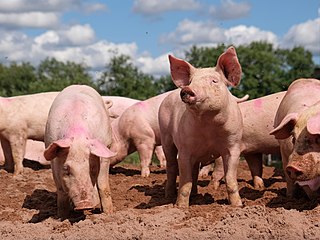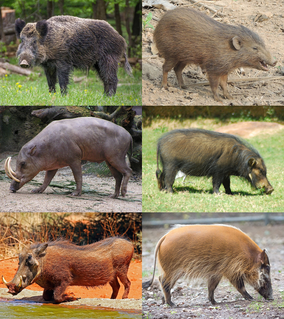
Sus is the genus of wild and domestic pigs, within the even-toed ungulate family Suidae. Sus include domestic pigs and their ancestor, the common Eurasian wild boar, along with other species. Sus species, like all suids, are native to the Eurasian and African continents, ranging from Europe to the Pacific islands. Suids other than the pig are the babirusa of Indonesia, the pygmy hog of South Asia, the warthogs of Africa, and other pig genera from Africa. The suids are a sister clade to peccaries.

The wild boar, also known as the wild swine, common wild pig, Eurasian wild pig, or simply wild pig, is a suid native to much of Eurasia and North Africa, and has been introduced to the Americas and Oceania. The species is now one of the widest-ranging mammals in the world, as well as the most widespread suiform. It has been assessed as least concern on the IUCN Red List due to its wide range, high numbers, and adaptability to a diversity of habitats. It has become an invasive species in part of its introduced range. Wild boars probably originated in Southeast Asia during the Early Pleistocene and outcompeted other suid species as they spread throughout the Old World.

Suidae is a family of artiodactyl mammals which are commonly called pigs, hogs, or boars. In addition to numerous fossil species, 18 extant species are currently recognized, classified into between four and eight genera. Within this family, the genus Sus includes the domestic pig, Sus scrofa domesticus or Sus domesticus, and many species of wild pig from Europe to the Pacific. Other genera include babirusas and warthogs. All suids, or swine, are native to the Old World, ranging from Asia to Europe and Africa.

The pig, often called swine, hog, or domesticpig when distinguishing from other members of the genus Sus, is an omnivorous, domesticated even-toed hoofed mammal. It is variously considered a subspecies of the Eurasian boar or a distinct species, but the American Society of Mammalogists considers it the latter. The pig's head-plus-body length ranges from 0.9 to 1.8 m, and adult pigs typically weigh between 50 and 350 kg, with well-fed individuals even exceeding this range. The size and weight of hogs largely depends on their breed. Compared to other artiodactyls, a pig's head is relatively long and pointed. Most even-toed ungulates are herbivorous, but pigs are omnivores, like their wild relative. Pigs grunt and make snorting sounds.

The pygmy hog is a suid native to alluvial grasslands in the foothills of the Himalayas at elevations of up to 300 m (980 ft). Today, the only known population lives in Assam, India and possibly southern Bhutan. As the population is estimated at less than 250 mature individuals, it is listed as Endangered on the IUCN Red List.

The Bornean bearded pig, also known ambiguously as the bearded pig, is a species in the pig genus, Sus.

The Visayan warty pig is a critically endangered species in the pig genus (Sus). It is endemic to six of the Visayan Islands in the central Philippines. It is known by many names in the region with most translating into 'wild pig': baboy ihalas, baboy talonon, baboy sulop, and baboy ramo.

The Philippine warty pig is one of four known species in the pig genus (Sus) endemic to the Philippines. The other three endemic species are the Visayan warty pig, Mindoro warty pig and the Palawan bearded pig, also being rare members of the family Suidae. Philippine warty pigs have two pairs of warts, with a tuft of hair extending outwards from the warts closest to the jaw. It has multiple native common names, but it is most widely known as baboy damo in Tagalog.

The Celebes warty pig, also called Sulawesi warty pig or Sulawesi pig, is a species in the pig genus (Sus) that lives on Sulawesi in Indonesia. It survives in most habitats and can live in altitudes of up to 2,500 m (8,000 ft). It has been domesticated and introduced to a number of other islands in Indonesia.

The Javan warty pig, also called Javan pig, is an even-toed ungulate in the family Suidae. It is endemic to the Indonesian islands Java and Bawean, and is considered extinct on Madura. It is listed as Endangered on the IUCN Red List since 1996.
Oliver's warty pig or Mindoro warty pig is a small species in the pig genus (Sus) which can only be found on the island of Mindoro in the central Philippines. This species previously treated to be a subspecies of S. philippensis, was shown to be morphologically and genetically different.
The Timor warty pig is a subspecies of Sus celebensis, or Celebes warty pig. Though described as a separate species, it is a feral form of the Celebes warty pig found in the Lesser Sunda Islands.
The Philippines (Filipino: has four endemic types of species of wild pigs. This makes the Philippines unique in having arguably the largest number of endemic wild pigs. Two separate populations of unstudied wild pig species have been reported on the islands of Tawi-Tawi, and Tablas.
A pig is a mammal of the genus Sus.

The Palawan bearded pig is a pig species in the genus Sus endemic to the Philippines, where it occurs on the archipelago of islands formed by Balabac, Palawan, and the Calamian Islands. It is 1 to 1.6 m in length, about 1 m (3.3 ft) tall and weigh up to 150 kg (330 lb).
Pigs may refer to members of the domestic pig subspecies, the Sus genus that includes the domestic pig, or the family Suidae that contains Sus.









